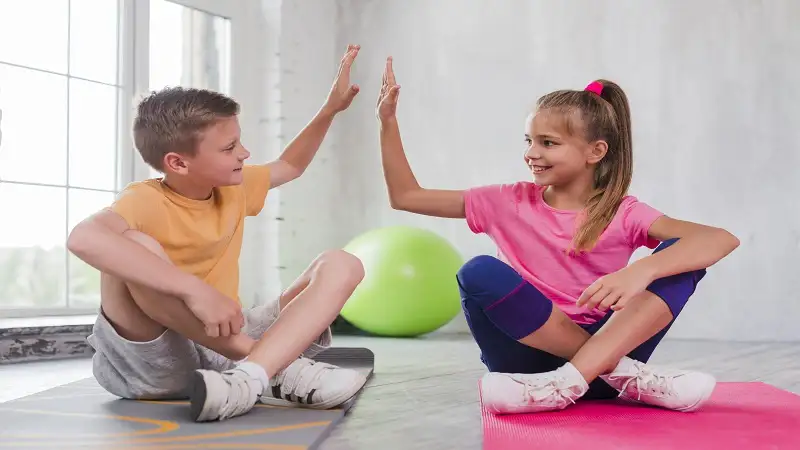In a world dominated by screens and technology, it’s more important than ever to encourage physical activity in children. One way to achieve this is by merging exercise with kids’ playtime. By turning physical activity into a fun and enjoyable experience, we can help children develop healthy habits that will last a lifetime, as explained at lasvegas.uptownjungle.com/. In this article, we’ll explore the importance of combining fitness with play, provide creative ideas for active play, and share insights into how parents and caregivers can make exercise a natural part of a child’s daily routine.
The Need for Active Play
The benefits of physical activity for children are numerous and far-reaching. Active play not only contributes to a child’s physical well-being but also supports their mental and emotional development.
Physical Health: Regular exercise helps children maintain a healthy weight, build strong muscles and bones, and improve cardiovascular fitness.
Mental Health: Physical activity releases endorphins, which can boost a child’s mood and reduce symptoms of anxiety and depression.
Cognitive Development: Active play can enhance a child’s cognitive abilities, including problem-solving, attention span, and memory.
Social Skills: Team sports and group activities encourage social interaction, cooperation, and communication.
Confidence Building: Achieving physical milestones and mastering new skills can boost a child’s self-esteem and confidence.
According to the World Health Organization (WHO), children aged 5-17 should engage in at least 60 minutes of moderate to vigorous physical activity every day.
Creative Playtime Ideas
Now, let’s dive into some creative playtime ideas that combine fun and fitness for kids.
Obstacle Course Adventures: Create an obstacle course in your backyard using cushions, hula hoops, and cones. Challenge your child to navigate through the course as fast as they can.
Dance Parties: Put on some music and have dance parties with your kids. Dancing is a great way to improve coordination and get their heart rates up.
Nature Scavenger Hunts: Go on nature walks and turn them into scavenger hunts. Make a list of items for your child to find, such as leaves, rocks, or flowers.
Bike Rides: Take family bike rides in the neighborhood or at a local park. Riding bikes is not only excellent exercise but also a fantastic way to explore the outdoors.
Jumping Fun: Invest in a mini-trampoline or simply have your child jump on the bed or a safe surface. Jumping helps with balance and coordination.
Yoga for Kids: There are kid-friendly yoga routines available online that can introduce your child to the benefits of stretching and mindfulness.
Skipping, a simple yet effective form of exercise, can burn around 200-300 calories in just 30 minutes.
Active Indoor Play
When the weather doesn’t cooperate, indoor activities can keep kids active and engaged.
Indoor Bowling: Set up a bowling alley using empty plastic bottles as pins and a soft ball as the bowling ball.
Living Room Campout: Create a fort with blankets and pillows, and have an indoor campout complete with stories and games.
Hopscotch: Use masking tape to create a hopscotch grid on your floor. It’s a great way to work on balance and coordination.
Balloon Volleyball: Blow up a balloon and play volleyball in your living room, using a piece of string or a makeshift net.
Indoor Mini Golf: Set up a mini-golf course using household objects as obstacles and a plastic golf club and ball.
Dance Mat Games: Invest in dance mat video games that encourage physical activity while having fun.
The world record for the longest hopscotch game is an astonishing 25,000 consecutive squares and was achieved in 2019.
Making Fitness a Routine
To ensure that exercise becomes a natural part of a child’s routine, consider 30 minutes practices, as well as these strategies:
Lead by Example: Children often mimic their parents’ behavior. If they see you being physically active, they are more likely to follow suit.
Schedule Active Time: Block out specific times for physical activity in your child’s daily schedule.
Limit Screen Time: Set screen time limits to ensure that children have ample opportunities for active play.
Encourage Outdoor Play: Spend time outdoors whenever possible. Nature provides endless opportunities for physical activity.
Family Fitness: Engage in physical activities as a family, such as hiking, biking, or playing sports together.
Praise Effort: Acknowledge and praise your child’s efforts during physical activities, even if they don’t excel at first.
The longest game of tag on record lasted for 30 years and involved a group of friends from Spokane, Washington.
Safety and Supervision
When promoting active play, safety is paramount. Ensure a safe environment for your child’s physical activities:
Safety Gear: When appropriate, ensure your child wears safety gear like helmets, knee pads, and elbow pads.
Supervision: Always supervise your child during physical activities, especially if they involve potentially dangerous elements.
Age-Appropriate Activities: Choose activities that are suitable for your child’s age and developmental stage.
Education: Teach your child about the importance of safety, such as looking both ways before crossing the street or wearing a helmet when riding a bike.
The highest recorded jump by a child on a pogo stick was 9 feet and 6 inches, achieved by Biff Hutchison in 1997.
Building Healthy Habits
Merging exercise with kids’ playtime is a fantastic way to promote physical health, cognitive development, and social skills in children. By introducing creative playtime ideas, making fitness a routine, and ensuring safety, parents and caregivers can lay the foundation for a healthy and active lifestyle that will benefit children throughout their lives.
Remember that the goal is not just to keep kids physically active but also to make exercise enjoyable and something they look forward to. With a little creativity and dedication, you can turn every playtime into an opportunity for your child to have fun, stay fit, and develop important life skills.
